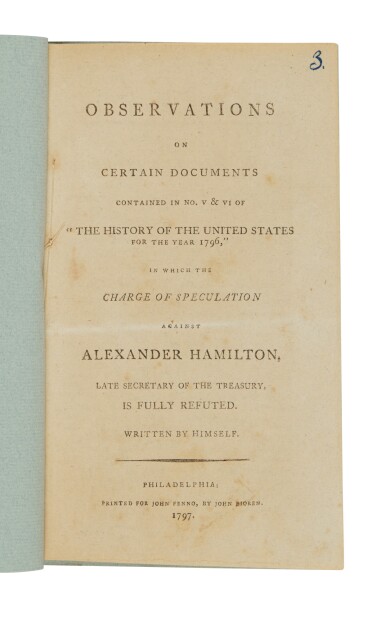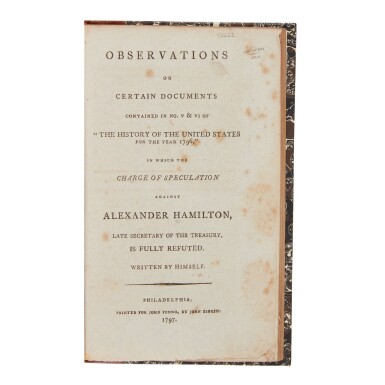First edition of Alexander Hamilton's fundamental report that ushered in the financial revolution in the United States "If the maintenance of public credit, then, be truly so important, the next enquiry which suggests itself is, by what means it is to be effected?—The ready answer to which question is, by good faith, by a punctual performance of contracts. States, like individuals, who observe their engagements, are respected and trusted: while the reverse is the fate of those, who pursue an opposite conduct...While the observance of that good faith, which is the basis of public credit, is recommended by the strongest inducements of political expediency, it is enforced by considerations of still greater authority...This reflection derives additional strength from the nature of the debt of the United States. It was the price of liberty." New-York: Francis Childs and John Swaine 1790. First edition. Folio, 13 1/4 x 8 1/2 in. (336 x 216mm). 51 pp. Gatherings stitched as issued, original thread sound; all edges untrimmed; title-page soiled and worn, 6 1/2 in. repaired closed tear to same; light dampstaining in margins and upper gutter; bottom of pp. 39/40 creased; scattered minor soiling to text; in red cloth slip case and chemise. Church 1253; Evans 22998; Ford, Bibliotheca Hamiltoniana 160 Rare first printing of the landmark document of American capitalism. Alexander Hamilton’s first major report as the first United States Secretary of the Treasury, outlining his visionary and controversial financial plans for the new nation. This document laid the groundwork for the establishment of the financial system of the United States, as he sought to restore the public credit of the country, and bind the states closer under the authority of the then new federal government. This document essentially constituted George Washington's legislative program during his first term and, conversely, planted the seeds for the creation of the political party system. Drawing on a variety of sources, including Hume, Montesquieu, Hobbes, and Postlethwayt, Hamilton's report sought to present, as Ron Chernow observes, a "broad political and economic vision" for the country, and sought to rescue the fledgling nation from its dire financial situation. By the time of this report's presentation to Congress, at the beginning of its second session on January 14, 1790, the country's finances were in a shambles. Following the Revolution, the federal government was essentially bankrupt, and it lacked the power to levy taxes and repay its financial obligations and debts, which by then were a staggering $79 million. According to Hamilton biographer, Robert Hendrickson, Hamilton's plan, laid out in this report, "constituted a seven-point legislative program of President Washington's first administration. The seven points were: 1. the restoration of public credit, 2. a sound system of taxation, 3. a national bank, 4. a sound currency, 5. the promotion of commerce, 6. a liberal immigration policy, and 7. the encouragement of manufactures..." Partisan lines quickly formed around those who were in support of Hamilton's agenda—the Federalists—and those who were against it—the so-called Jeffersonians or Democratic-Republicans—led by future presidents Thomas Jefferson and James Madison, of Virginia. Adverse to banking in general, and what they viewed as a system that resembled Great Britain in everything but name, Democratic-Republicans balked at Hamilton's ambitious agenda and warned of rampant speculation and the swindling of virtuous southern farmers by rich and corrupt northern bankers if passed into law. A centerpiece of Hamilton's plan was the assumption of state debts that remained from the Revolution under a single national debt that would be funded through a variety of new federal taxes, including an excise tax on whiskey, as well as tonnage duties and tariffs on imports. Democratic-Republicans opposed the idea because it would give too much power to the federal go
First edition of Alexander Hamilton's fundamental report that ushered in the financial revolution in the United States "If the maintenance of public credit, then, be truly so important, the next enquiry which suggests itself is, by what means it is to be effected?—The ready answer to which question is, by good faith, by a punctual performance of contracts. States, like individuals, who observe their engagements, are respected and trusted: while the reverse is the fate of those, who pursue an opposite conduct...While the observance of that good faith, which is the basis of public credit, is recommended by the strongest inducements of political expediency, it is enforced by considerations of still greater authority...This reflection derives additional strength from the nature of the debt of the United States. It was the price of liberty." New-York: Francis Childs and John Swaine 1790. First edition. Folio, 13 1/4 x 8 1/2 in. (336 x 216mm). 51 pp. Gatherings stitched as issued, original thread sound; all edges untrimmed; title-page soiled and worn, 6 1/2 in. repaired closed tear to same; light dampstaining in margins and upper gutter; bottom of pp. 39/40 creased; scattered minor soiling to text; in red cloth slip case and chemise. Church 1253; Evans 22998; Ford, Bibliotheca Hamiltoniana 160 Rare first printing of the landmark document of American capitalism. Alexander Hamilton’s first major report as the first United States Secretary of the Treasury, outlining his visionary and controversial financial plans for the new nation. This document laid the groundwork for the establishment of the financial system of the United States, as he sought to restore the public credit of the country, and bind the states closer under the authority of the then new federal government. This document essentially constituted George Washington's legislative program during his first term and, conversely, planted the seeds for the creation of the political party system. Drawing on a variety of sources, including Hume, Montesquieu, Hobbes, and Postlethwayt, Hamilton's report sought to present, as Ron Chernow observes, a "broad political and economic vision" for the country, and sought to rescue the fledgling nation from its dire financial situation. By the time of this report's presentation to Congress, at the beginning of its second session on January 14, 1790, the country's finances were in a shambles. Following the Revolution, the federal government was essentially bankrupt, and it lacked the power to levy taxes and repay its financial obligations and debts, which by then were a staggering $79 million. According to Hamilton biographer, Robert Hendrickson, Hamilton's plan, laid out in this report, "constituted a seven-point legislative program of President Washington's first administration. The seven points were: 1. the restoration of public credit, 2. a sound system of taxation, 3. a national bank, 4. a sound currency, 5. the promotion of commerce, 6. a liberal immigration policy, and 7. the encouragement of manufactures..." Partisan lines quickly formed around those who were in support of Hamilton's agenda—the Federalists—and those who were against it—the so-called Jeffersonians or Democratic-Republicans—led by future presidents Thomas Jefferson and James Madison, of Virginia. Adverse to banking in general, and what they viewed as a system that resembled Great Britain in everything but name, Democratic-Republicans balked at Hamilton's ambitious agenda and warned of rampant speculation and the swindling of virtuous southern farmers by rich and corrupt northern bankers if passed into law. A centerpiece of Hamilton's plan was the assumption of state debts that remained from the Revolution under a single national debt that would be funded through a variety of new federal taxes, including an excise tax on whiskey, as well as tonnage duties and tariffs on imports. Democratic-Republicans opposed the idea because it would give too much power to the federal go







.jpg)







Try LotSearch and its premium features for 7 days - without any costs!
Be notified automatically about new items in upcoming auctions.
Create an alert